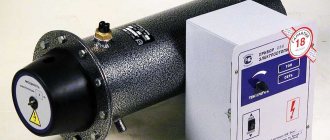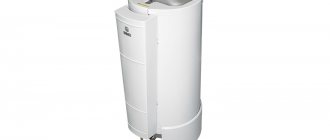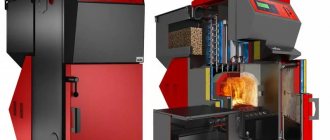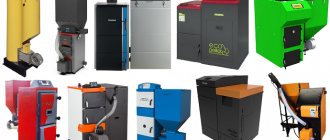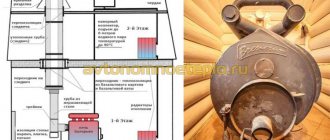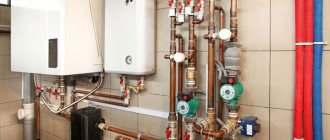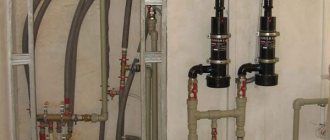To heat private residential buildings, electrical equipment is used that is connected to a household or industrial AC network. A detailed analysis of the operating principle and technical parameters makes it possible to find out which boiler is better - a heating element or an electrode one. The reliability of the heating circuit installed in the building depends on the correct choice of heating device.
Construction of heating element electric boilers
The operation of boiler heating elements is based on the passage of coolant through a container with installed tubular heating elements. Due to the high resistance of the spiral inside the tube, when current passes through the spiral, an increased amount of thermal energy is released. It goes into heating the coolant passing through the heating elements.
Automation of heating elements of boilers allows you to control their operation, temperature control and automatic switching on and off.
Principle of operation
Heating devices for heating systems connected to the electrical network are divided into 2 categories according to the principle of operation:
- with a tubular electric heater (TEH);
- with electrode block.
New heating element
Standard equipment uses a heating element to raise the temperature of the fluid.
The unit is a copper tube in which a spiral is installed. To increase operating efficiency and speed up warm-up, several elements are introduced into the design of the electric boiler. On the outer part of the heating block there are contacts for connecting the phase and neutral wires.
Heating of the spiral occurs due to the passage of current in accordance with the Joule-Lenz law.
Equipment advantages:
- No contact of live parts with the working fluid. The design is characterized by high electrical safety; the absence of leakage currents allows the introduction of an RCD protective unit into the power circuit.
- The power of the equipment is constant, the parameter does not depend on the temperature and chemical composition of the liquid. Power changes only as a result of voltage fluctuations in the network.
- The design of the heater allows for a smooth or step change in power, which eliminates a sharp surge in voltage in the network when the equipment is turned on or off.
- Failure of the heating element does not lead to a shutdown of the installation, since the design provides additional heaters.
- Operation of the equipment at elevated liquid temperatures is allowed. The degree of overheating is determined by the mechanical strength of the metal tank and the pipelines extending from the heater.
Electrode equipment
In electrode equipment, an electric current is passed through the working fluid; the design of the boilers includes metal electrodes to which the phase is connected. The neutral wire is connected to the installation body.
The coolant is heated in the working chamber due to the passage of electric current; the liquid circulates under the influence of a pump or naturally. Antifreeze liquids based on propylene glycol or ethylene glycol with the addition of corrosion inhibitors are used as the working substance.
Equipment advantages:
- There are no elements in the design that can fail. The deposition of scale on the surface of the tank or electrodes leads to a decrease in the efficiency of the boiler, but not its service life.
- In the absence of working fluid, the installation does not overheat, since the current does not pass through the air gap between the electrodes.
- Electrode heaters are characterized by reduced dimensions and low cost (the difference with standard products increases as the power of the installations increases).
Disadvantages of heating elements of boilers
Indirect heating of the coolant in the boiler heating element tank significantly increases its warming up time. It takes more than 10-15 minutes to heat up such a boiler.
This is a subjective drawback, which is perfectly compensated by the safety and clean operation of heating elements of boilers.
However, due to indirect heating, 10-15% of the heat generated by heating elements is lost during the warm-up stage. This negatively affects the efficiency of such boilers.
The weak point of the boiler heating elements are the heating elements themselves. Being constantly in an aggressive environment, they rust, are subject to corrosion and salt deposits. A simple metal heating element will require replacement after 5-6 years.
Efficiency comparison
The efficiency of the electrode boiler and devices with a heating element heater is the same, the parameter is in the range of 95-98%. But it takes 1-2 minutes to heat the liquid in equipment with electrodes to the required temperature, which is 3-5 times faster than in standard installations.
Accelerated heating is ensured by the thermal effect on the entire volume of working fluid placed in the boiler chamber. In products with heating elements, the temperature of the part of the liquid in contact with the surface of the metal heating element increases (up to 10% of the volume of liquid in the working chamber).
Water circulates through the heating circuit, warming the room. The temperature of the liquid decreases, so a boiler with a heating element needs to pump 5-6 times more water to warm it up to a given temperature than an installation with electrodes.
With the same power, the energy costs of installations differ several times. In this case, the product with a heating element operates at the nominal mode from the moment of startup, and the equipment with electrodes gains power as the liquid in the heating circuit warms up.
Types of heating elements of heaters
However, in addition to metal tubular heating elements, there are more expensive and durable analogues. Today you can find electric boilers with the following types of heating elements on sale:
- Metal alloy with cupronickel and nichrome;
- Heating elements made of ceramics;
- Heating elements made of composite materials.
The most expensive ceramic heating element has the longest service life.
Which is easier to use
Operation of a standard boiler does not require the preparation of liquid or the installation of protective equipment against electric shock. To turn on the equipment, you must press the button or move the lever of the package switch.
The installation will automatically heat the liquid to a predetermined temperature; the boiler design provides a separate circuit for preparing hot water, which is supplied through mixers to the bath or sink.
When using electrode installations, a reduction in the electrical conductivity of antifreeze is required. As electricity passes through the working fluid, the risk of electric shock increases. Protection using RCD devices is impossible, since the device will constantly operate, recording the leakage current.
When starting a cold installation, the supplied power may not be enough to start heating the room. To compensate for the deficiency, it is necessary to increase the temperature of the liquid (for example, using a tubular heater) or increase the electrical conductivity.
An increase in conductivity at low temperatures leads to an excessive increase in the parameter after heating the solution. As a result, the load on the power circuits and the electronic control unit increases. An additional problem is the possibility of breakdown of the gap between the electrodes filled with liquid.
As a result of a short circuit, a current surge occurs in the network, which disables the connected equipment. To organize hot water supply, it is necessary to install a second circuit, isolated from live parts.
Example of a boiler heating element
Let's look at the example of a popular manufacturer of heating elements for boilers, the Teplotech plant, boilers of the EVP brand (electric-water-heaters).
Boiler EVP-18M, 380 Volt
This boiler has a power of 18 kW, which is enough to heat a house with an area of 160 meters. The boiler costs 7800-7900 rubles. The high power of the boiler provides the possibility of three-phase power supply. However, this complicates its connection in the country houses of private individuals.
- This boiler has a large volume of heating flask, which allows the system coolant to be evenly heated without possible overheating.
- The boiler provides stepwise power switching. Switching is controlled by three keys from the control indication of the turned on power.
- The temperature of the coolant is monitored by a temperature sensor.
- It is possible to connect a temperature sensor in the rooms and limit the heating temperature of the rooms.
The boiler thermostat regulates the coolant temperature in the range from 0 to 85°C.
©Obotoplenii.ru
More articles
- Heating scheme for a house up to 100 meters
- Glass heaters
- Baseboard heating: description, application
- Heating the house with an electric boiler
- Electric heating boiler (electric boiler): device, connection to power supply
What difficulties arise in servicing?
During operation of equipment with thermal elements, the tank or heating unit fails. But since the boiler design includes several heating elements, water heating will continue. The owner is informed about the trouble that has arisen using control LEDs. Some installations use a display that displays an error code.
When tap water is heated, a layer of scale forms on the surface of the heater and tank, which impairs heat transfer. Overheating of the spiral leads to a reduction in service life, so periodic flushing of the boiler with a special solution is required.
To reduce the negative effect, devices are installed in front of the heating block to reduce the hardness of the liquid. An alternative solution is to fill the heating system with distilled water, which continuously circulates in the circuit.
When liquid leaks from the tank, the power to the heating element is automatically interrupted. But if the protection system fails, the heating element overheats, creating a risk of fire in the installation or electrical wiring. When installing equipment, you should duplicate protection against emergency situations and install additional fuses.
The stability of operation of electrode equipment depends on the quality of the coolant, which degrades and loses its characteristics during operation. The passage of electric current promotes the decomposition of antifreeze, the resulting gases accumulate in the tank.
When the pump operates, air pockets form in the heating circuit, negatively affecting the performance of the radiators. Manufacturers of electrode heating systems recommend replacing the fluid in the circuits (the service life depends on the chemical composition of the solution).
Manufacturers
| Manufacturer | Characteristic |
| Galan (Russia) | Use of imported components. Reliable automation. Low cost. |
| Nevsky (Russia) | Use in closed heating systems. Automation that can switch modes and turn off the boiler. Reliable assembly and high-quality components. |
| Dakon (Czech Republic) | More than 30 models. They can come complete with circulation pumps, expansion tanks and other additional components. |
| Kospel (Poland) | Single-circuit models. Higher cost compared to Russian models. |
As a result, a heating element electric boiler is a functional device that performs its tasks efficiently.
Summarizing
Electrode installations have increased reliability and safety in the event of a liquid supply interruption, but the equipment requires the preparation of a special solution. When the device operates, stray currents arise that destroy metal parts of the structure.
Equipment production is carried out by small companies, while electrode boilers do not provide energy savings. Therefore, it is recommended to use standard heating devices with heating elements produced by large companies in homes.
Advantages and disadvantages
Heating element electric boilers are characterized by many advantages:
- The power is not changeable and the coolant temperature does not affect it in any way.
- Heating elements are in no way connected to the coolant. Therefore, such a boiler is safer, there is no current leakage, and it is possible to install an RCD.
- The power can be easily adjusted, which means that there will be virtually no power surges when turning the boiler on and off.
- Boilers can operate on antifreeze, antifreeze, or water. There is no need to specially prepare water for electrical conductivity.
- If one tubular electric heater breaks down, the boiler will continue to function.
- Can operate on superheated water.
- In order to carry out maintenance of heating element boilers, no special knowledge is needed.
The appearance of electric boilers is aesthetic, and they are also small in size. A variety of models will allow you to choose a unit to suit every taste.
Disadvantages of heating element electric boilers:
- The heating element has a limited service life and can burn out, so when choosing a boiler, be sure to check whether the heating elements can be replaced.
- The formation of various deposits on heating elements impairs their cooling, which leads to premature failure, therefore, it is better to play it safe and take measures to reduce the hardness of the water poured into the system.
Under no circumstances should the device be allowed to operate without water (dry running), because this will certainly lead to failure of the heating elements and a fire hazard may arise. It is best to install a water flow sensor.
